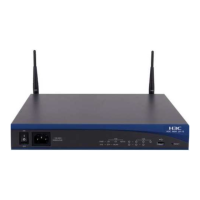l Configuring an IGP for the MPLS backbone network in each AS to implement IP
connectivity within an AS
l Configuring basic MPLS functions on the MPLS backbone network of each AS
l Configuring a VSI on the PE connected to the CE and binding the VSI to an AC interface
l Configuring an IP address for the interface connecting the CE to the PE
l Establishing a tunnel between a PE and an ASBR-PE in the same AS (Option A)
Data Preparation
To configure the inter-AS Kompella VPLS, you need the following data.
No. Data
1 Data used to create a VSI on a PE and an ASBR-PE:
l VSI name and RD
l (Optional) Description of the VSI
l VPN target
l (Optional) Routing policy that controls the sending and receiving of information
about VPLS label blocks
l (Optional) Tunnel policy
l (Optional) Maximum number of label blocks stored in a VSI
2
CE ID of a site, maximum number of permitted CEs that access the VPLS, and default
offset value of the CE ID
3 PE interfaces to which VSIs are bound
4 AS number of each PE
5 IP addresses and interfaces used to establish IBGP peer relationships between PEs
and ASBR-PEs
6.8.2 Configuring Inter-AS Kompella VPLS Option A
Context
The configurations of inter-AS Kompella VPLS Option A can be described as follows:
l Configuring Kompella VPLS for each AS
l Configuring an ASBR-PE by considering the peer ASBR-PE as its CE
l Configuring a VSI on a PE and an ASBR-PE respectively and binding the VSIs to related
AC interfaces (The PE accesses a CE; the ASBR-PE accesses the peer ASBR-PE.)
NOTE
In inter-AS VPLS Option A, for the same VPLS network, the VPN target of the VSI on an ASBR-PE and
that on a PE in the same AS must be matched. The VPN target of the VSI on an ASBR-PE and that on a
PE in different ASs need not to be matched.
Quidway S9300 Terabit Routing Switch
Configuration Guide - VPN 6 VPLS Configuration
Issue 03 (2009-08-20) Huawei Proprietary and Confidential
Copyright © Huawei Technologies Co., Ltd.
6-29

